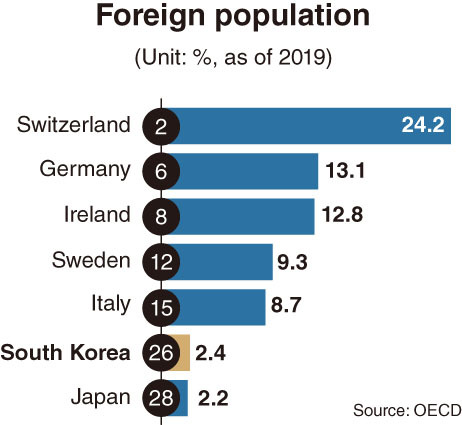[News Focus] Korea 26th of 33 OECD members in foreign residents’ share of population
By Kim Yon-sePublished : Feb. 14, 2021 - 15:56

SEJONG -- The number of registered foreign residents in South Korea came to 1.27 million at the end of 2019, making up 2.4 percent of the population of 51.84 million.
The nation saw its foreign population climb quickly, from 1.7 percent a decade earlier in 2009 when 870,600 of Korea’s 49.77 million people where non-citizens.
But the figure for Korea is still behind of the average of the Organization for Economic Cooperation and Development, which compared 33 of its total 37 members for 2019 figures or the latest available.
Among the 33, 11 members had foreign populations above 10 percent, and 12 members with 5-10 percent. Korea ranked 26th with a proportion of 2.4 percent.
Luxembourg topped the list with 47.3 percent, followed by Switzerland with 24.2 percent, Estonia with 16.3 percent, Austria with 16.1 percent, Latvia with 14 percent and Germany with 13.1 percent.

This shows that the figures were high among countries that border several neighboring countries.
Luxembourg is surrounded by three countries and Switzerland by five neighboring countries. Austria borders eight countries -- Germany, the Czech Republic, Slovakia, Hungary, Slovenia, Italy, Switzerland and Liechtenstein.
Among the top 15 in the portion of foreign residents were Iceland (13.1 percent), Ireland (12.8 percent), Belgium (12.3 percent), Norway (10.9 percent), Spain (10.4 percent), Sweden (9.3 percent), Denmark (9.1 percent), the UK (9 percent) and Italy (8.7).
The next-rankers included France at 7.3 percent, the US at 6.9 percent, Slovenia at 6.6 percent, Canada at 6.6 percent, the Netherlands at 6.5 percent and the Czech Republic at 5.3 percent.
Among others outstripping Korea were Chile (5.3 percent), Greece (5.1 percent), Portugal (4.7 percent) and Finland (4.7 percent).
Japan ranked behind Korea with 2.2 percent. Hungary was further behind with 1.9 percent, whereas Lithuania had 1.7 percent, Slovakia had 1.4 percent and Turkey had 1.1 percent.
Two countries -- Poland with 0.6 percent and Mexico with 0.4 percent -- posted figures under 1 percent.
In Korea, the tally for registered foreign residents topped the 1 million mark in 2014, and continued to increase to 1.14 million in 2015, 1.16 million in 2016, 1.17 million in 2017 and 1.24 million in 2018.
After reaching to an all-time high of 1.27 million in December 2019, the figure declined to 1.17 million as of October 2020 in the wake of the novel coronavirus. As a result, the portion of expatriate population inched down to 2.2 percent, marking a 0.2 percentage point decline in only 10 months.
In part, Korea’s low percentage arises from the way it keeps its statistics.
Registered foreign residents are foreign nationals staying long-term in Korea. The figure does not include 461,000 people in Korea on F-4 visas – a long-term residence visa for people of Korean heritage.
If they were included, total long-term residents would come to 1.63 million, or 3.1 percent but this would not change Korea’s ranking, as the next-ranked country, Finland, has 4.7 percent of it’s population made up by foreign nationals.
As the number of short-term visitors posted 441,000 in the month, the total number of foreign nationals in the nation reached 2.07 million as of October 2020.
The Justice Ministry defines long-term visitors as people staying in Korea for 91 days or longer, and short-term visitors as those with permission to stay in Korea for no more than 90 days.
By Kim Yon-se (kys@heraldcorp.com)



![[Herald Interview] 'Amid aging population, Korea to invite more young professionals from overseas'](http://res.heraldm.com/phpwas/restmb_idxmake.php?idx=644&simg=/content/image/2024/04/24/20240424050844_0.jpg&u=20240424200058)












![[KH Explains] Korean shipbuilding stocks rally: Real growth or bubble?](http://res.heraldm.com/phpwas/restmb_idxmake.php?idx=652&simg=/content/image/2024/04/25/20240425050656_0.jpg&u=)

